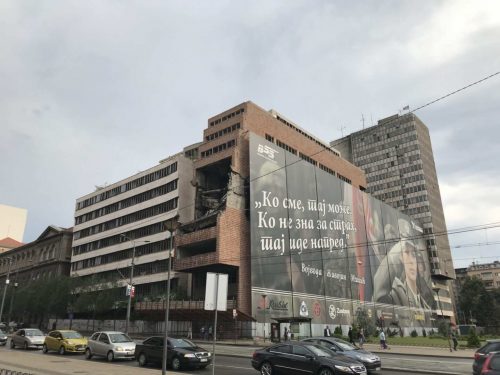
Although “Belgrade” in the local language (Beo-Grad) means “white city”, you can not walk on the streets without noticing the colorful graffiti depicting various motifs: humorous comment on local culture, scars of the past, concern for the environment, and satire of commercialism… just to name a few.
To me, nearly every graffiti painting I have encountered in Belgrade makes me slow down my steps. They all seem to possess a palpable immediacy, vividness, and intimacy that many artworks in the newly opened museum of contemporary art do not have. I soon learned that the history of Belgrade’s graffiti culture dates back to the 1980s, and its trends and motives constantly evolve as the country experiences disintegration, wars, and reconstruction.
Naturally, I began to develop some seemingly pretentious philosophical inquires: Do pains of the past and discontents of the present empower the art? What role does art serve in expressing, reconciling and calling for actions?
I brought the two questions to my organization, Heartefact, a cultural NGO that aspires to promote inter-cultural and inter-regional discussions through theatre productions.
In my first few weeks, I learned about the works Heartefact have done and I feel like I am getting an answer to my questions, on how art could raise awareness and empower people. I watched the footage of the “48 Hours of Awarkeness” that Heartefact organized in 2015 in response to the refugee crisis: artists and the public are invited to read texts about the refugee from antiquity to the present day for 48 hours. I read about the recent theatre performances that Heartefact produced: the short-lived refuge of the Soviet theorist Shlkovsky in Berlin, or the life of a Kosovar mother and her daughter-in-law after the son disappear during the war.
You see, art is the medium that engages people and draws them emotionally closer to social issues: By reading out loud, it is as if the reader is also experiencing what the refugees have gone through; By telling the story of refuge and of missing, the theatre serves as a form of cathexis, reminding the audience of the vicissitudes that the country has experienced and will continue to experience.
It’s all so heavy, I know, just like the ruins of NATO bombing silently stand near the center of the city, like a perfect analogy for Balkan arts: carrying the scars of the past and witnessing the scramble of the present.

But the story does not end here.
Out of curiosity, I asked my co-worker if they ever do any production that is simply light-hearted, that depicts beauty and serenity, that is non-related to wars, refuge, and hardship, but just little moments of exuberance.
She did not laugh at my question. “But who will give us money to do THAT?”
At that moment, I realized that there is a more complicated image of being an artist in a post-conflict society like Serbia.
When you do a theatre production and 60% of which is founded by the European Commission, when your NGO receives grants from organizations like the Rockefeller Foundation and Liberal Democrats Foundation, you are expected to act in a certain way and pursue certain themes.
It might just be an unconscious choice, of artists, of the western organizations who provide funds, and of Serbian’s very own Ministry of Culture. Deal with these heavy, painful, tireless, peculiar themes: make war, reconcile, remember the pains.
Why not, because you feel it, and they want it. No one is entitled to judge.
At least I know I am not, so I am ending my blog with a Balkan artist’s advice to those who want to become a Balkan artist.
“Tear up your passport. Think inside the box.”[1]
[1] A guide to being a Balkan Artist, by Artrit Bytyci. Kosovo 2.0, 2013.
